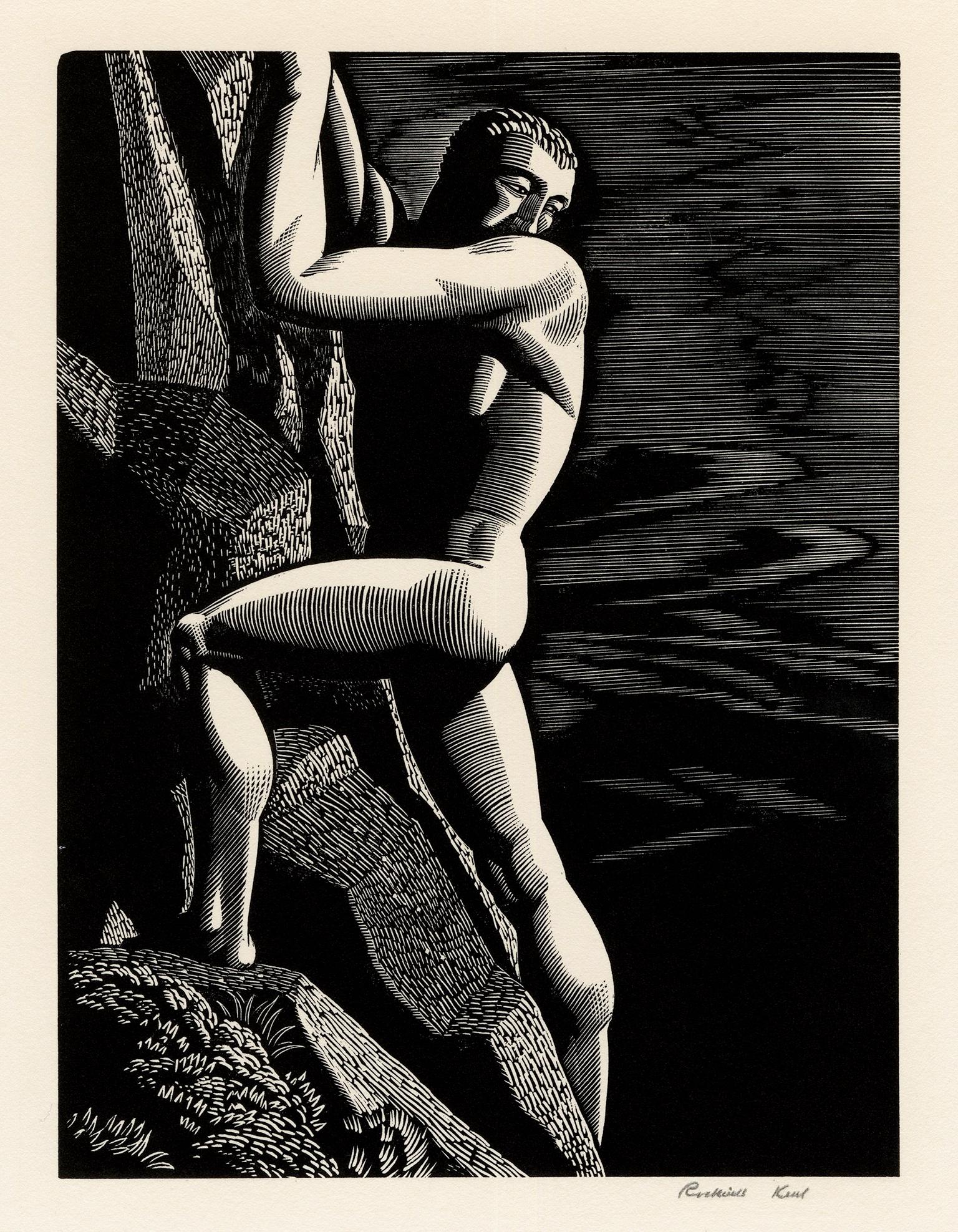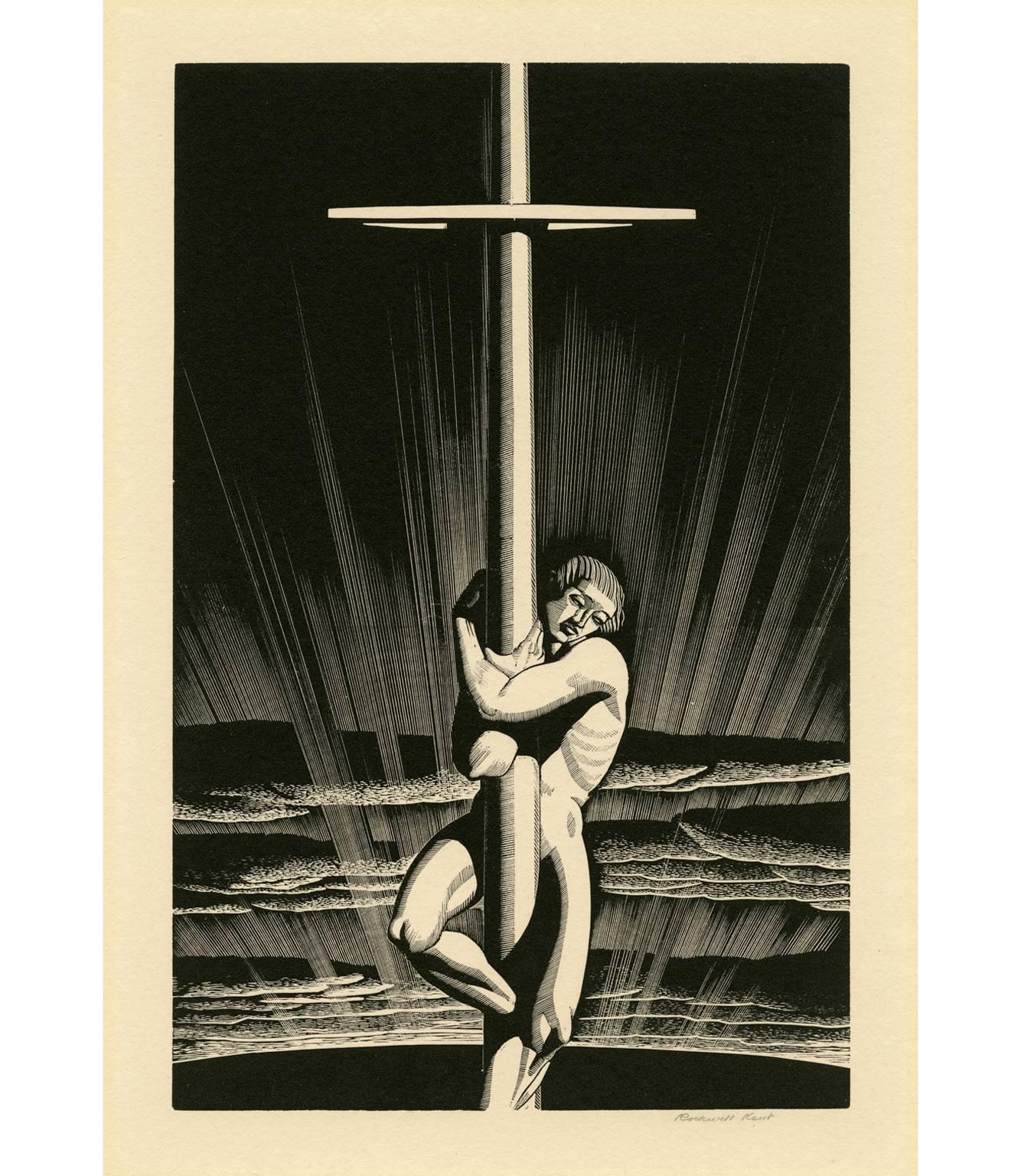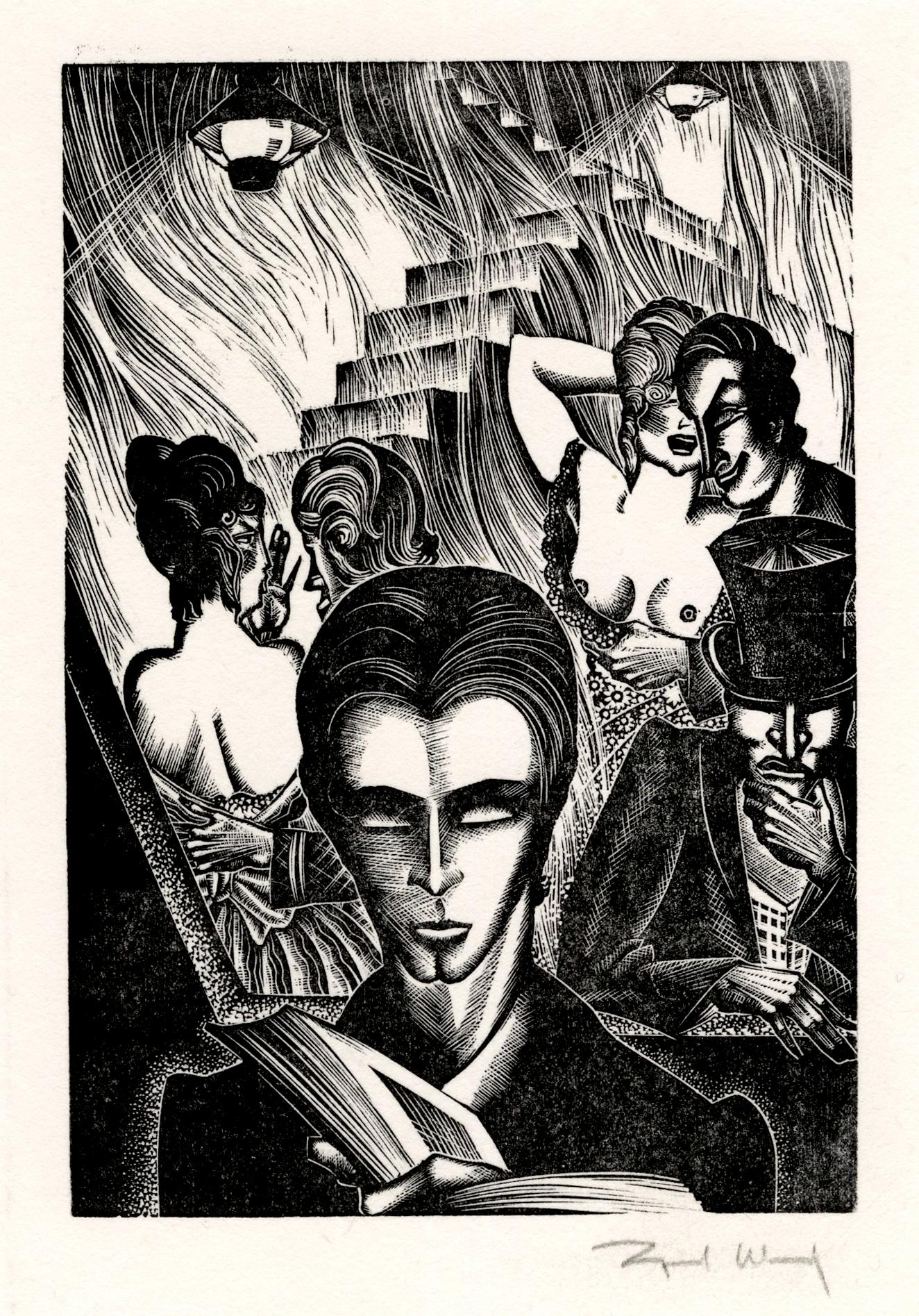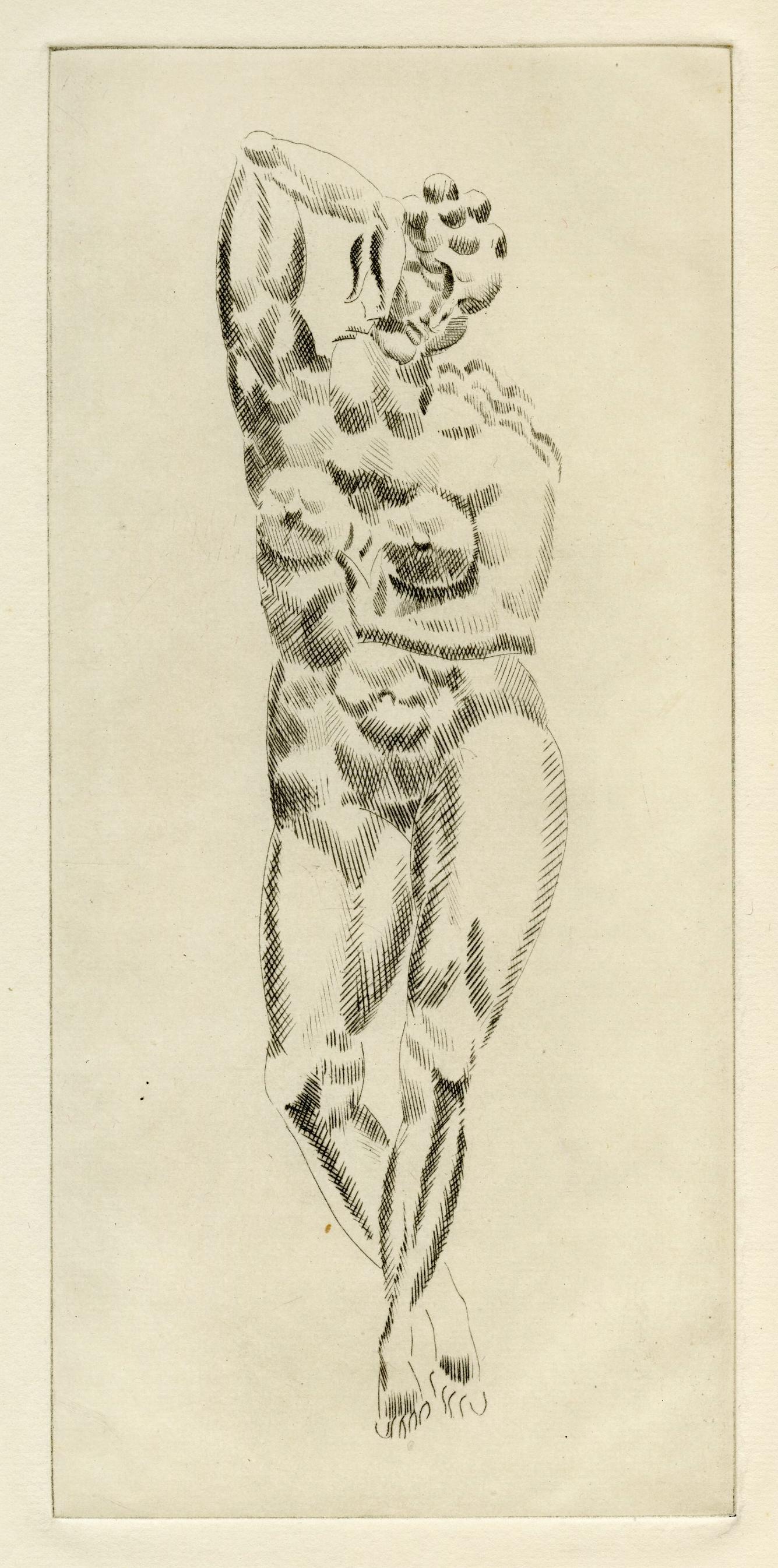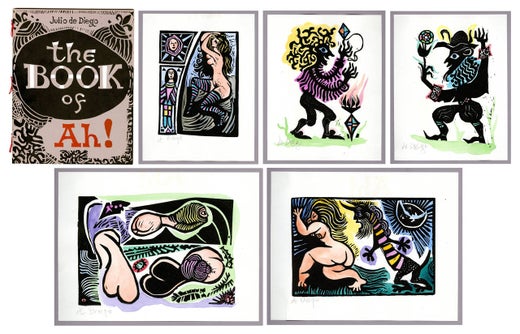Julio de DiegoThe Book of Ah!1969
1969
About the Item
- Creator:Julio de Diego (1900-1979, American)
- Creation Year:1969
- Dimensions:Height: 12.75 in (32.39 cm)Width: 10 in (25.4 cm)
- Medium:
- Movement & Style:
- Period:
- Condition:
- Gallery Location:Fairlawn, OH
- Reference Number:
Julio de Diego
Julio De Diego was one of the most colorful artists to work in Chicago. Born in Madrid in 1900, he left home at the age of 15 to apprentice as a scene painter for theatres. After service in the Spanish army, including six months fighting in North Africa, Diego traveled to Paris and Rome to study art. He also appeared as an extra in Diaghilev’s Ballet Russes. He emigrated to the United States in 1924. He lived in New York for two years, then went to Chicago, where he remained until 1942. At first, he earned a living as a magazine illustrator, decorative painter and graphic designer. By the early 1930s, Diego began to show regularly at the Art Institute of Chicago, appearing at thirty-two annual exhibitions of Chicago Artists, American artists and watercolorists, between 1931–47. He was employed by the easel division of the Illinois Art Project during the mid-1930s. He traveled to Mexico for the first time in 1939, becoming close friends with Carlos Mérida. Diego was deeply affected by the Spanish Civil War, and many of his works reflect the conflict that presaged the Second World War. Meditation over Inexplicable Logic seems to be a kind of preparation for his self-portrait in the Art Institute’s collection, titled The Perplexity of What To Do (1940). Both feature isolated, brooding figures lost in their inability to respond to events. He left Chicago in 1942 but continued to exhibit his work at major institutions. In 1946, Life magazine’s article described him spending time “cooking aromatic Spanish dishes and reading works of Spanish mystical philosophers and poets. He smokes cigarettes incessantly and dresses flamboyantly, affecting cerise mufflers and jangling bracelets.” Diego gained more notoriety in 1948 when he married the great burlesque artist, Gypsy Rose Lee. After their separation and divorce in the mid-1950s, he lived for a time in New York at the Chelsea Hotel, a haunt of artists, musicians and poets. Diego settled in Sarasota, Florida in 1967, near former friends from Chicago, where he died in 1979. Daniel Schulman References “Julio De Diego: He Paints Weird War and Peace.” Life Magazine, March 11, 1946. De Diego, Julio. Pamphlet File P-07866. Ryerson Library, Art Institute of Chicago.
- ShippingRetrieving quote...Ships From: Fairlawn, OH
- Return PolicyA return for this item may be initiated within 10 days of delivery.
- Female Nude - Standing Female Nude (Havard)By Elie NadelmanLocated in Fairlawn, OHFemale Nude - Standing Female Nude (Havard) Drypoint, 1920 Unsigned, as issued in the portfolio No signed impression are known to exist From: The Drypoint...Category
1920s American Modern Nude Prints
MaterialsDrypoint
- ArisingBy Alessandro Mastro-ValerioLocated in Fairlawn, OHArising Mezzotint, 1942 Signed in pencil lower right (see photo) Publisher : Issued by the Miniature Print Collectors Society. Edition: 200 Condition: Mint Archival framing with Museum Glass Image/Plate size: 2 3/8 x 2 7/8 inches Sheet size: 3 3/4 x 4 5/8 inches Archival Framed: 17 1/4 x 15 1/4 inches Mastro-Valerio was educated at the Salvador Rosa Institute in Naples, Italy (1906-1912), and came to the U.S. in 1913. He settled in Chicago, and after a brief period as a commerical artist, established a portrait studio near the Loop. Among his patrons were the industrialists Harvey S...Category
1940s American Modern Nude Prints
MaterialsMezzotint
- Beauty and the BeastBy Adolf DehnLocated in Fairlawn, OHBeauty and the Beast Lithograph, 1949 Signed, titled and numbered in pencil (see photos) Edition: 20 (10/20) (see photo) Condition: Excellent cond...Category
1940s American Modern Nude Prints
MaterialsLithograph
- Plate 2By Matt PhillipsLocated in Fairlawn, OHPlate 2 2 plate drypoint with hand coloring, 1984 Signed and numbered in pencil (see photos) From: Barcelona Suite (6 plates) Edition: A/P 8/10 in pencil lower left Signed in pen...Category
1980s American Modern Nude Prints
MaterialsDrypoint
- Ecce Homo Plate XBy Werner DrewesLocated in Fairlawn, OHEcce Homo Plate X Woodcut, 1921 Signed, titled, and dated in pencil by the artist (see photos) Edition: One of two known impressions This image wwas unknown to the catloger Ingrid Ro...Category
1920s Bauhaus Nude Prints
MaterialsWoodcut
- Homme nu avec femme ivre et jeune flutisteBy Pablo PicassoLocated in Fairlawn, OHHomme nu avec femme ivre et jeune flutiste Etching, 1955 Signature stamp lower right (see photo) Annotated in penci lower leftl: "epreuve d'artiste" (see photo) Inventory number vers...Category
1950s Modern Nude Prints
MaterialsEtching
- 'Mountain Climber' — 1930s American ModernismBy Rockwell KentLocated in Myrtle Beach, SCRockwell Kent, 'Mountain Climber', wood engraving, 1933, edition 250, Burne Jones 93. Signed in pencil. A brilliant, black impression, on cream, wove Japan paper; the full sheet with margins (2 9/16 to 3 5/8 inches); slight skinning at the top sheet edge verso, where previously hinged; otherwise, in excellent condition. Archivally matted to museum standards, unframed. Image size 7 7/8 x 5 7/8 inches (200 x 149 mm); sheet size 14 x 11 1/8 inches (356 x 283 mm). Printed by Pynson Printers, New York. Distributed by The Print Club of Cleveland, Publication No. 11, 1933. Literature: 'Rockwellkentiana,' Harcourt, Brace and Company, New York, 1933. '101 of The World’s Greatest Books', edited by Spencer Armstrong, 1950. Impressions of this work are held in the following museum collections: Akron Art Institute, Burne Jones Collection, IL; Cincinnati Art Museum; Cleveland Museum of Art; Columbus Gallery of Fine Arts; Crystal Bridges Museum of American Art; Davis Museum at Wellesley College; Fine Art Museums of San Francisco; H. M. de Young Museum; Hermitage Museum; Kent Collection, NY; Library of Congress; Memorial Art Gallery, University of Rochester; Metropolitan Museum of Art; New York Public Library; Philadelphia Museum of Art; Princeton University Library; Smithsonian American Art Museum, Spector Collection, NY; SUNY, Plattsburg. ABOUT THE ARTIST Rockwell Kent (1882-1971), though best known as a painter, graphic artist, and illustrator, pursued many careers throughout his life, including architect, carpenter, explorer, writer, dairy farmer, and political activist. Born in Tarrytown, New York, Kent was interested in art from a young age. These ambitions were encouraged by his aunt Jo Holgate, an accomplished ceramicist. Jo came to live with the family after Kent’s father passed away in 1887 and took him to Europe as a teenager, undoubtedly kindling his interest in exploring the world. Kent attended the Horace Mann School in New York City, where he excelled at mechanical drawing. His family’s financial circumstances prevented him from pursuing a career in the fine arts; however, after graduating from Horace Mann in 1900, Kent decided to study architecture at Columbia University. Before matriculating at Columbia, Kent spent the first of three consecutive summers studying painting at William Merritt Chase’s art school in Shinnecock Hills, Long Island. There he found a community of mentors and fellow students who encouraged him to pursue his interest in art. At the end of Kent’s third summer at Shinnecock, Chase offered him a full scholarship to the New York School of Art, where he was a teacher. Kent began taking night classes at the art school in addition to his architecture studies but soon left Columbia to study painting full-time. In addition to Chase, Kent took classes with Robert Henri and Kenneth Hayes Miller, where his classmates included the artists George Bellows and Edward Hopper. Kent spent the summer of 1903 assisting the eccentric painter Abbott Handerson Thayer at his studio in Dublin, New Hampshire—a position he secured through the recommendation of his Aunt Jo. Thayer’s naturalist lifestyle and almost mystical appreciation for natural phenomena greatly influenced Kent; he returned to Dublin for many years to visit Thayer and his family. Thayer gave the young artist time to pursue his work, and that summer Kent painted several views of the New Hampshire landscape, including Mount Monadnock. In 1905 Kent moved from New York to Monhegan Island in Maine, home to a summer art colony, where he continued to find inspiration in nature. Kent soon found success exhibiting and selling his paintings in New York, and in 1907, he was given his first solo show at Claussen Galleries. The following year he married his first wife, Kathleen Whiting (Thayer’s niece), with whom he had five children. The couple divorced in 1924, and Kent married Frances Lee the following year. They divorced after 15 years of marriage, and the artist married Sally Johnstone. For the next several decades, Kent lived a peripatetic lifestyle, settling in several locations in Connecticut, Maine, and New York. During this time he took several extended voyages to remote, often ice-filled, corners of the globe, including Newfoundland, Alaska, Tierra del Fuego, and Greenland, to which he made three separate trips. For Kent, exploration and artistic production were twinned endeavors, and his travels to these rugged, elemental locations inspired his visual art and his writings. He developed a stark, realist landscape style in his paintings and drawings that revealed both nature’s harshness and its sublimity. Kent’s human figures, which appear sparingly in his work, often allude to the mythic themes of isolation, individualism, heroism, and the quest for self-connection. Important exhibitions of works from these travels include the Knoedler Gallery’s shows in 1919 and 1920, featuring Kent’s Alaska drawings...Category
1930s American Modern Nude Prints
MaterialsWoodcut
- 'Sea And Sky' — 1930s ModernismBy Rockwell KentLocated in Myrtle Beach, SCA brilliant, black impression, on cream wove Japan; the full sheet with margins (2 to 2 1/2 inches), in excellent condition. Edition 150. Signed in pencil. Matted to museum standards...Category
1930s American Modern Nude Prints
MaterialsWoodcut
- 'The Bather' — 1930s American ModernismBy Rockwell KentLocated in Myrtle Beach, SCRockwell Kent, 'The Bather', wood engraving, 1931, edition 120, Burne Jones 63. Signed in pencil. A brilliant, black impression, on cream, wove Japan paper; the full sheet with margins (2 1/2 to 3 1/4 inches); slight skinning at the top sheet edge, verso, otherwise in excellent condition. Image size 5 3/8 x 7 7/8 inches (137 x 200 mm); sheet size 11 1/8 x 14 1/2 inches (283 x 368 mm). Archivally matted to museum standards, unframed. Impressions of this work are held in the following public collections: Burne Jones Collection, IL; Chegodaev Collection, Moscow; Kent Collection, NY; Philadelphia Museum of Art; Princeton University Library, NJ; Pushkin Museum, Moscow; Smithsonian American Art Museum, Spector Collection, NY. Rockwell Kent (1882-1971), though best known as a painter, graphic artist, and illustrator, pursued many careers throughout his life, including architect, carpenter, explorer, writer, dairy farmer, and political activist. Born in Tarrytown, New York, Kent was interested in art from a young age. These ambitions were encouraged by his aunt Jo Holgate, an accomplished ceramicist. Jo came to live with the family after Kent’s father passed away in 1887 and took him to Europe as a teenager, undoubtedly kindling his interest in exploring the world. Kent attended the Horace Mann School in New York City, where he excelled at mechanical drawing. His family’s financial circumstances prevented him from pursuing a career in the fine arts; however, after graduating from Horace Mann in 1900, Kent decided to study architecture at Columbia University. Before matriculating at Columbia, Kent spent the first of three consecutive summers studying painting at William Merritt Chase’s art school in Shinnecock Hills, Long Island. There he found a community of mentors and fellow students who encouraged him to pursue his interest in art. At the end of Kent’s third summer at Shinnecock, Chase offered him a full scholarship to the New York School of Art, where he was a teacher. Kent began taking night classes at the art school in addition to his architecture studies but soon left Columbia to study painting full-time. In addition to Chase, Kent took classes with Robert Henri and Kenneth Hayes Miller, where his classmates included the artists George Bellows and Edward Hopper. Kent spent the summer of 1903 assisting the eccentric painter Abbott Handerson Thayer at his studio in Dublin, New Hampshire—a position he secured through the recommendation of his Aunt Jo. Thayer’s naturalist lifestyle and almost mystical appreciation for natural phenomena greatly influenced Kent; he returned to Dublin for many years to visit Thayer and his family. Thayer gave the young artist time to pursue his work, and that summer Kent painted several views of the New Hampshire landscape, including Mount Monadnock...Category
1930s American Modern Nude Prints
MaterialsWoodcut
- 'Madman's Drum (Plate 41)' — 1930s Graphic ModernismBy Lynd WardLocated in Myrtle Beach, SCLynd Ward, 'Madman's Drum, Plate 41', wood engraving, 1930, edition small. Signed in pencil. A fine, black impression, on off-white tissue-thin Japan paper; the full sheet with margins (1 5/8 to 2 1/2 inches); a small paper blemish in the upper right margin, away from the image, otherwise in excellent condition. Scarce. Matted to museum standards, unframed. Image size 5 1/2 x 3 3/4 inches (140 x 95 mm); sheet size 9 5/8 x 7 1/8 inches (244 x 181 mm). From Lynd Ward’s book of illustrations without words, 'Madman’s Drum', Jonathan Cape and Harrison Smith, New York, 1930. Illustrated in 'Storyteller Without Words: The Wood Engravings of Lynd Ward', Harry Abrams, New York, 1974. Reproduced in 'Storyteller Without Words, the Wood Engravings of Lynd Ward', Harry N. Abrams, New York, 1974. ABOUT THE ARTIST Lynd Ward is acknowledged as one of America’s foremost wood engravers and book illustrators of the first half of the twentieth century. His innovative use of narrative printmaking as a stand-alone storytelling vehicle was uniquely successful in reaching a broad audience. The powerful psychological intensity of his work, celebrated for its dynamic design, technical precision, and compelling dramatic content, finds resonance in the literature of Poe, Melville, and Hawthorne. Like these classic American writers, Ward was concerned with the themes of man’s inner struggles and the role of the subconscious in determining his destiny. An artist of social conscience during the Great Depression and World War II, he infused his graphic images with his unique brand of social realism, deftly portraying the problems that challenged the ideals of American society. The son of a Methodist preacher, Lynd Ward, moved from Chicago to Massachusetts at an early age. He graduated from the Teachers College of Columbia University, New York, in 1926, where he studied illustration and graphic arts. He married May Yonge McNeer in 1936 and left for Europe for their honeymoon in Eastern Europe. After four months, they settled in Leipzig, where Ward studied at the National Academy of Graphic Arts and Bookmaking. Inspired by Belgian expressionist artist Frans Masereel's graphic novel ‘The Sun,’ and another graphic novel by the German artist Otto Nückel, ‘Destiny,’ he determined to create his own "wordless" novel. Upon his return to America, Ward completed his first book, ‘God's Man: A Novel in Woodcuts,’ published in 1929. ‘Gods’ Man’ was a great success for its author and publisher and was reprinted four times in 1930, including a British edition. This book and several which followed it, ‘Madman’s Drum,’ 1930, ‘Wild Pilgrimage...Category
1930s American Modern Figurative Prints
MaterialsWoodcut
- September MornBy Joseph HirschLocated in New Orleans, LAThree women strolling on a beach. This impression is one of the rare impressions printed monochromatically. Hirsch natural inclination was to print in lack and white but reprinted ...Category
1960s American Modern Nude Prints
MaterialsLithograph
- Original Palm Springs Desert Oasis psychedelic vintage posterLocated in Spokane, WAOriginal poster: Palm Springs The Desert Oasis original poster by Bill Ogden. The poster is not linen-backed. Excellent condition. Mint. 1969. ...Category
1960s American Modern Nude Prints
MaterialsOffset
